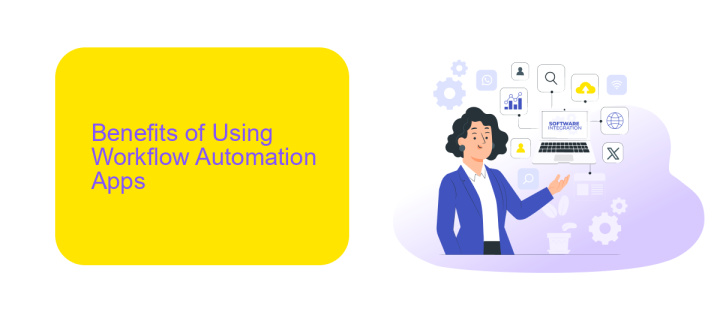Workflow Automation Apps
In today's fast-paced business environment, workflow automation apps have become essential tools for enhancing productivity and efficiency. These applications streamline repetitive tasks, reduce human error, and free up valuable time for employees to focus on more strategic activities. This article explores the top workflow automation apps, their features, and how they can transform your daily operations for the better.
What are Workflow Automation Apps?
Workflow Automation Apps are tools designed to streamline and automate repetitive tasks and processes within various business workflows. These apps help reduce manual effort, minimize errors, and improve overall efficiency by automating routine activities.
- Task automation: Automate repetitive tasks such as data entry, email notifications, and report generation.
- Integration: Connect different apps and services to create seamless workflows. For example, ApiX-Drive allows you to integrate various platforms effortlessly.
- Process optimization: Identify bottlenecks and inefficiencies in workflows and automate them for smoother operations.
- Scalability: Easily scale operations by automating tasks, allowing businesses to handle larger volumes of work without additional resources.
- Time-saving: Free up valuable time for employees to focus on more strategic and creative tasks.
By utilizing Workflow Automation Apps, businesses can enhance productivity, reduce operational costs, and ensure consistency in their processes. Tools like ApiX-Drive play a crucial role in enabling seamless integration between different services, making it easier to set up and manage automated workflows.
Benefits of Using Workflow Automation Apps

Workflow automation apps offer significant benefits by streamlining repetitive tasks and enhancing productivity. By automating routine processes, employees can focus on more strategic activities, leading to better resource allocation and improved efficiency. These apps also reduce the likelihood of human error, ensuring that tasks are completed accurately and on time. This not only saves time but also enhances the overall quality of work, contributing to higher customer satisfaction and business growth.
Another key advantage is the seamless integration with various tools and platforms. Services like ApiX-Drive facilitate easy setup of integrations, allowing different applications to communicate effectively without manual intervention. This ensures a smooth flow of information across different systems, enabling real-time updates and more informed decision-making. Additionally, workflow automation apps provide valuable insights through analytics, helping businesses identify bottlenecks and optimize processes for continuous improvement.
Types of Workflow Automation Apps

Workflow automation apps are essential tools for streamlining business processes, improving efficiency, and reducing manual tasks. These applications come in various types, each designed to cater to specific needs and functionalities.
- Task Automation Apps: These apps focus on automating repetitive tasks such as data entry, email responses, and scheduling. Examples include Zapier and Microsoft Power Automate.
- Process Automation Apps: These applications automate entire business processes, from start to finish. They are ideal for workflows that require multiple steps and approvals. Examples include Nintex and Kissflow.
- Integration Platforms: These services, like ApiX-Drive, specialize in connecting different software and applications, allowing seamless data transfer and communication between them. They are crucial for businesses that use multiple tools and need them to work together efficiently.
- Robotic Process Automation (RPA): RPA tools automate complex and rule-based tasks by mimicking human interactions with software. Examples include UiPath and Automation Anywhere.
Choosing the right type of workflow automation app depends on your specific business needs and the complexity of the tasks you want to automate. Whether you need simple task automation or robust process integration, there's a solution available to enhance your productivity.
How to Choose the Right Workflow Automation App

Choosing the right workflow automation app can significantly enhance your productivity and streamline your business processes. To make an informed decision, start by identifying your specific needs and objectives. Understand the tasks you want to automate and the integrations required to achieve seamless operations.
Next, evaluate the features and capabilities of various workflow automation apps. Look for user-friendly interfaces, scalability, and customization options. Ensure the app supports the platforms and tools your team already uses, such as CRM systems, email services, and project management software.
- Identify your automation needs and objectives.
- Evaluate features and capabilities.
- Check compatibility with existing tools.
- Consider user reviews and testimonials.
- Assess pricing and scalability.
For seamless integration, consider using services like ApiX-Drive, which allows you to connect various apps and automate workflows effortlessly. By carefully assessing your needs and the app's features, you can choose a workflow automation solution that best fits your business requirements.
Tips for Implementing Workflow Automation Apps
When implementing workflow automation apps, it's crucial to start with a clear understanding of your existing processes. Map out each step and identify areas where automation can bring the most value. This will help you set realistic goals and choose the right tools. Additionally, involve your team in the planning process to ensure that the automation aligns with their daily tasks and improves overall efficiency.
Another essential tip is to focus on integration capabilities. Choose automation apps that can seamlessly integrate with your existing software and tools. Services like ApiX-Drive can significantly simplify this process by offering pre-built integrations and an easy-to-use interface. This ensures that data flows smoothly between different systems, reducing manual work and minimizing errors. Regularly review and update your automation workflows to adapt to changing business needs and maintain optimal performance.
FAQ
What is workflow automation?
How can I integrate different apps for workflow automation?
What types of tasks can be automated?
Is it difficult to set up workflow automation?
What are the benefits of using workflow automation apps?
Do you want to achieve your goals in business, career and life faster and better? Do it with ApiX-Drive – a tool that will remove a significant part of the routine from workflows and free up additional time to achieve your goals. Test the capabilities of Apix-Drive for free – see for yourself the effectiveness of the tool.

